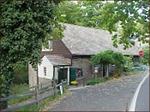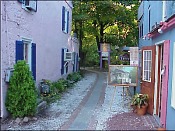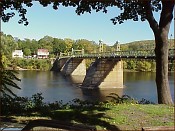
by Dr. Lori Verderame
New Hope, PA Artist Colony
The New Hope, Pennsylvania artist colony focuses on the Pennsylvania Impressionists, the New Hope Modernists, and the historic region as a major American art colony. Highlighting the importance of the Delaware River and the Delaware Canal on the area, famous figures from the area (stage coach era bank robbers named the Doan brothers) and prominent architectural sites in New Hope from the Revolutionary War era to the present.

Bucks County origins
Bucks County was one of three original counties of Pennsylvania established by William Penn in November 1682. The county’s name derived from the name Buckinghamshire, the county in England where Penn’s family lived for generations.
The earliest inhabitants of Bucks County were the Lenni Lenape Indians. They lived mostly along the Delaware River and the Neshaminy Creek. The white settlers favored development of communities along the Delaware River and as such, New Hope, PA became an industrial center consisting of mills and farms. Farming was the primary occupation of most county inhabitants with mills established along the creeks and streams to grind grain or provide lumber to the growing society.
Most of Bucks County’s roads were dotted with inns, taverns, and other places to take rest in order to serve travelers enroute to and from New York and Philadelphia. These establishments were always welcomed stops for farmers as they traveled to Philadelphia’s markets and butcher shops.
One of the areas best known Pennsylvania Impressionist artists was Edward Redfield who lived in Centre Bridge, PA. Redfield painted many lovely scenes of the area. The Centre Bridge Inn is an example of the beautiful sites that sparked Redfield’s creativity.
Daniel Garber resided within Solebury township near the Cuttalossa Creek near New Hope, PA and painted in an Impressionistic/Tonalist style similar to that of American expatriate artist, James A. M. Whistler. History has placed Daniel Garber within the context of Pennsylvania Impressionism and the artists of the Pennsylvania Academy of the Fine Arts.
The New Hope Modernists led by artists working from the art enclave of West Mechanic Street in New Hope, were fed up with the conservative leanings of the Impressionists and Phillips Mills’ juries. They decided, in 1930 to boycott the annual Phillips Mill art exhibition and schedule their own independent art show. This show premiered one day prior to the opening of the annual Phillips Mill show in mid May. The modern artists working in New Hope included such masters as: Lloyd (Bill) Ney, Adolph Blondheim, Charles Evans, Peter Keenan, Ralston Crawford, Charles F. Ramsey, B.J.O. Nordfeldt, Charles Rosen, Louis Stone, Elsie Driggs, and Lee Gatch.
While the Precisionist painter and well known American modernist, Charles Sheeler lived in nearby Doylestown, PA, he did not have a close association with the New Hope Modernists.

The bridges at New Hope, Riegelsville, and Easton along the Delaware provided subject matter for painters and photographers working in this area for decades. Artists including WPA photographer Walker Evans, New Hope Impressionist John Folinsbee and modernist Charles Ramsey have all captured these bridges as subjects for works of art.
Canal Murals
There are four murals located on South Main Street in New Hope which capture the history of the Delaware Canal and trace the Delaware Canal’s construction extending 60 miles which took place in the late 1820s. The mural panels depict the industrial significance of the Canal, the Clock Tower in Bristol, the lock at Point Pleasant, PA (north of New Hope), and the famous mules walking along the towpath that pulled canal boats. The murals are installed adjacent to lock #11 at New Hope.
Robert Rosenwald’s sculpture is a major part of New Hope’s history. Like the murals which dot the landscape referencing the Impressionist and Realistic styles, public sculpture is a major part of the history and art of the town. The sculpture defines the tradition of public art in the region. New Hope’s first public sculpture commission, Sign of the Times, by Rosenwald demonstrates the sculptor’s command of minimalist constructions and post-modern symbolism. The constructed metal piece recalls the post-war tradition of factory-inspired sculpture and conveys Rosenwald’s mastery for uniting direct context with structure captivating all who view it.
Ney Alley and W. Mechanic Street
The entrance to Ney Alley on West Mechanic Street once served as an artist’s studio space, art enclave, and fine art gallery. As it was in the early 20th Century, this location at 15 W. Mechanic Street continues to be a point of entry to the Delaware Canal for artists. The mural reflects upon the favorite subject matter of the New Hope School of Impressionism, the Delaware Canal.
In the tradition of the painters of the New Hope School (a.k.a., the Pennsylvania Impressionists including Edward Redfield, Walter Baum, Walter Schofield, Fern Coppedge, and others), contemporary artists painted this grand mural located over 15 West Mechanic Street in New Hope.
Ney Alley was best known for providing the Pennsylvania Impressionists with a meeting place as well as a place to set up their easels and paint scenes of the Delaware Canal. These artists painted outdoors and directly captured each season on canvas using the same soft color palette and loose brushwork that was used for this Impressionist mural.
There were many mills up and down the Delaware River such as the mills at New Hope and Stover Mill in Erwinna, Tinicum Township, Bucks County, PA.
First known as a gristmill, the New Hope Mill (now the site of the Bucks County Playhouse) was also a working sawmill before becoming the site of the Bucks County Playhouse. The Bucks County Playhouse is a well documented starting point for actors, composers, and playwrights headed for the bright lights of Broadway.
The New Hope Railroad Station has a traditional candlesnuffer roof form atop its prominent 19th century turret.
Many artists have been unable to resist the New Hope Railroad station stop when considering subjects for a painting. In the early decades of the 1900s, Ralston Crawford (American, 1906-1978) painted a wonderful work based on the structure which is in the collection of the nearby Allentown Art Museum in Allentown, PA. More recently, local artist, Joseph Crilley painted the same scene of the New Hope and Ivyland Railroad in his own colorful and expressionistic style.
The turret is reminiscent of Victorian architecture. The candlesnuffer roof form is not native to Pennsylvania architecture since Pennsylvania does not experience the excessive snowfall amounts where this roofline is typically employed. Candlesnuffer roofs are more frequently found in Germany, Scandinavia, Austria, and other northern European and alpine areas.
The candlesnuffer roof is also found in New England states in the US. Its severe pitch sheds water and snow very well and the form was introduced into this area by the Pennsylvania Germans in the late 17th Century.
The towpath was the site where many artists placed their easels in order to capture landscape compositions en plein aire (painting outdoors) throughout the four seasons. Called the towpath because this pathway was reserved for the hardworking mules that towed barges carrying coal from the northern regions of Pennsylvania down the Delaware Canal to points south.
Ney Alley and the Delaware Canal provided superb subject matter for the New Hope Impressionists and the New Hope Modernists.


